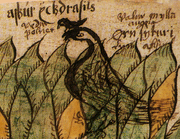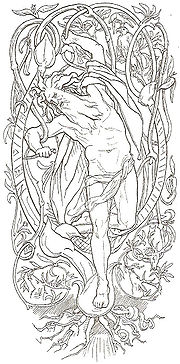
Veðrfölnir
Encyclopedia

Norse mythology
Norse mythology, a subset of Germanic mythology, is the overall term for the myths, legends and beliefs about supernatural beings of Norse pagans. It flourished prior to the Christianization of Scandinavia, during the Early Middle Ages, and passed into Nordic folklore, with some aspects surviving...
, Veðrfölnir (Old Norse
Old Norse
Old Norse is a North Germanic language that was spoken by inhabitants of Scandinavia and inhabitants of their overseas settlements during the Viking Age, until about 1300....
"storm pale," "wind bleached" or "wind-witherer") is a hawk
Hawk
The term hawk can be used in several ways:* In strict usage in Australia and Africa, to mean any of the species in the subfamily Accipitrinae, which comprises the genera Accipiter, Micronisus, Melierax, Urotriorchis and Megatriorchis. The large and widespread Accipiter genus includes goshawks,...
sitting between the eyes of an unnamed eagle that is perched on top of the world tree
World tree
The world tree is a motif present in several religions and mythologies, particularly Indo-European religions, Siberian religions, and Native American religions. The world tree is represented as a colossal tree which supports the heavens, thereby connecting the heavens, the earth, and, through its...
Yggdrasil
Yggdrasil
In Norse mythology, Yggdrasil is an immense tree that is central in Norse cosmology. It was said to be the world tree around which the nine worlds existed...
. Veðrfölnir is sometimes modernly anglicized
Anglicisation
Anglicisation, or anglicization , is the process of converting verbal or written elements of any other language into a form that is more comprehensible to an English speaker, or, more generally, of altering something such that it becomes English in form or character.The term most often refers to...
as Vedrfolnir or Vethrfolnir.
The unnamed eagle is attested in both the Poetic Edda
Poetic Edda
The Poetic Edda is a collection of Old Norse poems primarily preserved in the Icelandic mediaeval manuscript Codex Regius. Along with Snorri Sturluson's Prose Edda, the Poetic Edda is the most important extant source on Norse mythology and Germanic heroic legends, and from the early 19th century...
, compiled in the 13th century from earlier traditional sources, and the Prose Edda
Prose Edda
The Prose Edda, also known as the Younger Edda, Snorri's Edda or simply Edda, is an Icelandic collection of four sections interspersed with excerpts from earlier skaldic and Eddic poetry containing tales from Nordic mythology...
, written in the 13th century by Snorri Sturluson
Snorri Sturluson
Snorri Sturluson was an Icelandic historian, poet, and politician. He was twice elected lawspeaker at the Icelandic parliament, the Althing...
, while Veðrfölnir is solely attested in the Prose Edda
Prose Edda
The Prose Edda, also known as the Younger Edda, Snorri's Edda or simply Edda, is an Icelandic collection of four sections interspersed with excerpts from earlier skaldic and Eddic poetry containing tales from Nordic mythology...
. In both the Poetic Edda and the Prose Edda, the squirrel Ratatoskr couriers messages between the unnamed eagle and Nidhöggr, the wyrm
Dragon
A dragon is a legendary creature, typically with serpentine or reptilian traits, that feature in the myths of many cultures. There are two distinct cultural traditions of dragons: the European dragon, derived from European folk traditions and ultimately related to Greek and Middle Eastern...
that resides below the world tree. Scholars have proposed theories about the implications of the birds.
Attestations

Grímnismál
Grímnismál is one of the mythological poems of the Poetic Edda. It is preserved in the Codex Regius manuscript and the AM 748 I 4to fragment. It is spoken through the voice of Grímnir, one of the many guises of the god Odin, who is tortured by King Geirröth...
, the god Odin
Odin
Odin is a major god in Norse mythology and the ruler of Asgard. Homologous with the Anglo-Saxon "Wōden" and the Old High German "Wotan", the name is descended from Proto-Germanic "*Wodanaz" or "*Wōđanaz"....
(disguised as Grimnir) says that:
- Benjamin Thorpe
Benjamin ThorpeBenjamin Thorpe was an English scholar of Anglo-Saxon.-Biography:After studying for four years at Copenhagen University, under the Danish philologist Rasmus Christian Rask, he returned to England in 1830, and in 1832 published an English version of Caedmon's metrical paraphrase of portions of the...
translation:- Ratatösk is the squirrel named, who has run
- in Yggdrasil's ash;
- he from above the eagle's words must carry,
- and beneath the Nidhögg repeat.
Henry Adams Bellows Henry Adams BellowsHenry Adams Bellows was a lawyer, state legislator, and jurist born in Rockingham, Vermont. He was elected to the New Hampshire House of Representatives from Littleton, New Hampshire in 1839. He was subsequently elected again to the House from Concord, New Hampshire in 1856–1857, and served as...
translation:Ratatosk is the squirrel who there shall run On the ash-tree Yggdrasil; From above the words of the eagle he bears, And tells them to Nithhogg beneath.
The eagle is again attested in chapter 16 of the Prose Edda book Gylfaginning
Gylfaginning
Gylfaginning, or the Tricking of Gylfi , is the first part of Snorri Sturluson's Prose Edda after Prologue. The Gylfaginning deals with the creation and destruction of the world of the Norse gods, and many other aspects of Norse mythology...
, yet here with the company of Veðrfölnir. In the chapter, Gangleri
Gangleri
Gangleri may refer to:* one of Odin's many nicknames meaning "the wanderer" or "Wayweary"* the name of the ancient Swedish king Gylfi, given while in disguise, as described in the book Gylfaginning collected in the Prose Edda...
(described as king Gylfi
Gylfi
In Norse mythology, Gylfi, Gylfe, Gylvi, or Gylve was the earliest king in Scandinavia recorded. The traditions on Gylfi deal with how he was tricked by the gods and his relations with the goddess Gefjon.-The creation of Zealand:...
in disguise) asks the enthroned figure of High
High, Just-As-High, and Third
High, Just-As-High, and Third are three men that respond to questions posed by Gangleri in the Prose Edda book Gylfaginning...
what other notable facts there are to know about Yggdrasil. High responds (Veðrfölnir is here anglicized as Vedrfolnir):
- 'There is much to be told. An eagle sits at the top of the ash, and it has knowledge of many things. Between its eyes sits the hawk called Vedrfolnir [...]. The squirrel called Ratatosk runs up and down the ash. He tells slanderous gossip, provoking the eagle and Nidhogg
NíðhöggrIn Norse mythology, Níðhöggr is a dragon who gnaws at a root of the World Tree, Yggdrasill.-Prose Edda:...
.'
Theories
John LindowJohn Lindow
John Lindow is a professor specializing in Scandinavian medieval studies and folklore at the University of California, Berkeley and author. Lindow's works include Norse Mythology: A Guide to the Gods, Rituals, and Beliefs, a handbook for Norse mythology...
points out that Snorri does not say why a hawk should be sitting between the eyes of an eagle or what role it may play. Lindow theorizes that "presumably the hawk is associated with the wisdom of the eagle" and that "perhaps, like Odin's ravens, it flies off acquiring and bringing back knowledge".
Hilda Ellis Davidson says that the notion of an eagle atop a tree and the World Serpent coiled around the roots of the tree has parallels in other cosmologies from Asia
Asia
Asia is the world's largest and most populous continent, located primarily in the eastern and northern hemispheres. It covers 8.7% of the Earth's total surface area and with approximately 3.879 billion people, it hosts 60% of the world's current human population...
, and that Norse cosmology may have been influenced by these Asiatic cosmologies from a northern route. On the other hand, Davidson adds, the Germanic peoples are attested as worshipping their deities in open forest clearings, and that a sky god was particularly connected with the oak
Oak
An oak is a tree or shrub in the genus Quercus , of which about 600 species exist. "Oak" may also appear in the names of species in related genera, notably Lithocarpus...
tree, and therefore "a central tree was a natural symbol for them also".
See also
- HræsvelgrHræsvelgrIn Norse mythology, Hræsvelgr is a giant who takes eagle form. According to stanza 37 of the poem Vafþrúðnismál from the Poetic Edda, he sits at the end of the world and causes the wind to blow when he beats his wings in flight...
, a jötunn in the form of an eagle - Víðópnir, the rooster that sits atop the tree MímameiðrMímameiðrIn Norse mythology, Mímameiðr is a tree whose branches stretch over every land, is unharmed by fire or metal, bears fruit that assists pregnant women, and upon whose highest bough roosts the cock Víðópnir. Mímameiðr is solely attested in the Old Norse poem Fjölsvinnsmál...

